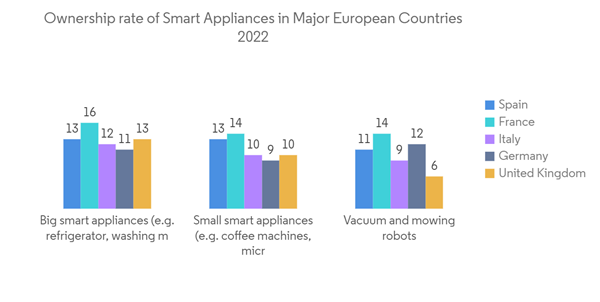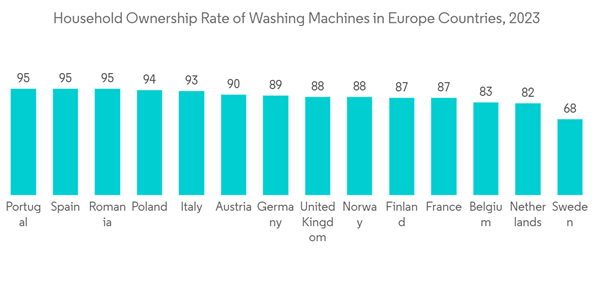The European Kitchen Appliances Market is valued at USD 178 Billion and is expected to register a CAGR of greater than 7% during the forecasted period.
Europe's kitchen appliances market was experiencing steady growth and innovation across various product categories. The transition to more innovative and energy-efficient and technologically upgraded appliances is the major driving force behind the growth of the kitchen appliances market in the European Union. Owing to the ongoing COVID-19 pandemic the market has been under pressure since mid-February 2020 which restricted the construction of housing and building projects the lockdown restrictions have limited new purchases owing to the uncertainty in the economy and purchasing power parity but are anticipated to bounce back during the forecast period with the changing situations and customers approach towards the pandemic.
The growing digitalization is shaping the future of the market. The number of smart homes, which is constantly growing is adding an advantage to the market by increasing the usage of connected appliances in the region. Similarly, distribution is notably tending towards channels featuring high discounts, including private label goods outlets, and mega markets offering high discounts through tax rebates and tie-ups with manufacturers. The growing e-commerce has been posing as a major competitor to other sellers due to highly competitive discounts and other offers have emerged as the fastest growing segment of the distribution channels in the year 2020, owing to the closure of physical stores for a longer time due to the COVID-19 pandemic.
The adoption of smart home technology is also influencing the kitchen appliances market in Europe. Smart kitchen appliances with internet connectivity and smartphone integration allow users to control and monitor their devices remotely, enhancing convenience and functionality. Built-in kitchen appliances, such as built-in ovens and integrated dishwashers, are gaining popularity in Europe due to their seamless and space-saving designs that blend into kitchen cabinetry. European consumers place a high emphasis on design and aesthetics in their kitchen appliances. Manufacturers are offering appliances with sleek and modern designs that complement contemporary kitchen styles.
This product will be delivered within 2 business days.
Europe's kitchen appliances market was experiencing steady growth and innovation across various product categories. The transition to more innovative and energy-efficient and technologically upgraded appliances is the major driving force behind the growth of the kitchen appliances market in the European Union. Owing to the ongoing COVID-19 pandemic the market has been under pressure since mid-February 2020 which restricted the construction of housing and building projects the lockdown restrictions have limited new purchases owing to the uncertainty in the economy and purchasing power parity but are anticipated to bounce back during the forecast period with the changing situations and customers approach towards the pandemic.
The growing digitalization is shaping the future of the market. The number of smart homes, which is constantly growing is adding an advantage to the market by increasing the usage of connected appliances in the region. Similarly, distribution is notably tending towards channels featuring high discounts, including private label goods outlets, and mega markets offering high discounts through tax rebates and tie-ups with manufacturers. The growing e-commerce has been posing as a major competitor to other sellers due to highly competitive discounts and other offers have emerged as the fastest growing segment of the distribution channels in the year 2020, owing to the closure of physical stores for a longer time due to the COVID-19 pandemic.
The adoption of smart home technology is also influencing the kitchen appliances market in Europe. Smart kitchen appliances with internet connectivity and smartphone integration allow users to control and monitor their devices remotely, enhancing convenience and functionality. Built-in kitchen appliances, such as built-in ovens and integrated dishwashers, are gaining popularity in Europe due to their seamless and space-saving designs that blend into kitchen cabinetry. European consumers place a high emphasis on design and aesthetics in their kitchen appliances. Manufacturers are offering appliances with sleek and modern designs that complement contemporary kitchen styles.
European Kitchen Appliances Market Trends
Smart Appliance are providing Opportunities for Customization and Personalization
Smart appliances have been making a notable impact on the kitchen appliances market in Europe. Their emphasis on energy efficiency, sustainability, and seamless integration with smart homes has resonated well with European consumers. Smart appliances have been experiencing increased adoption in Europe, driven by factors such as rising consumer awareness of smart home technology, improvements in connectivity infrastructure, and the desire for greater convenience and efficiency in household tasks. The European market has shown a strong emphasis on energy efficiency and sustainability. Smart appliances, with their advanced energy-saving features and the ability to optimize usage based on real-time data, align well with the region's focus on environmental responsibility. European consumers are embracing smart home ecosystems, and smart appliances play a vital role in this integration. By connecting kitchen appliances with other smart devices and virtual assistants, users can create a seamless and connected living experience.Minimum 85% of house holds have the Washing Machines in Europe
Washing machines are among the most common and essential kitchen appliances. High ownership rates in mature markets can drive manufacturers to focus on product innovation and differentiation to entice consumers to upgrade their existing washing machines. This might lead to the introduction of advanced features, energy-efficient models, and smart technology integration, which could benefit the overall kitchen appliances market as manufacturers try to stay competitive. The ownership rate of washing machines can influence cross-selling opportunities for other kitchen appliances. For example, if a household already has a washing machine, they might be more likely to consider complementary appliances such as dryers or dishwashers. Higher ownership rates of washing machines can thus positively impact sales of related kitchen appliances. High ownership rates of washing machines can contribute to higher energy consumption and water usage. In response, there may be increased consumer demand for eco-friendly and energy-efficient washing machines. This demand could drive manufacturers to develop more sustainable appliances across the kitchen appliances market.European Kitchen Appliances Industry Overview
The Europe Kitchen appliances market is highly competitive with a high number of key players operating in the market. The report covers the profiles of major players operating in the region. In terms of market share, some of the major players currently dominate the market. However, with technological advancement and product innovation, mid-size to smaller companies are increasing their market presence by securing new contracts and by tapping new markets. Market dynamics such as consumer preferences for energy efficiency, smart connectivity, and innovative design have driven competition in the European kitchen appliances market. Manufacturers have been investing in research and development to differentiate their products, enhance user experience, and align with sustainability trends. Following is the list of companies operating in the market Electrolux AB, BSH Hausgerate GmbH, LG Electronics, Koninklijke Philips N.V., Smeg S.p.A.Additional Benefits:
- The market estimate (ME) sheet in Excel format
- 3 months of analyst support
This product will be delivered within 2 business days.
Table of Contents
1 INTRODUCTION
4 MARKET INSIGHTS AND DYNAMICS
5 MARKET SEGMENTATION
6 COMPETITIVE LANDSCAPE
Companies Mentioned (Partial List)
A selection of companies mentioned in this report includes, but is not limited to:
- Electrolux AB
- BSH Hausgerate GmbH
- LG Electronics
- Koninklijke Philips N.V.
- Smeg S.p.A.
- Miele
- Whirlpool Corp
- Russell Hobbs
- Morphy Richards
- Samsung*
Methodology

LOADING...










